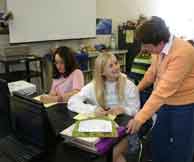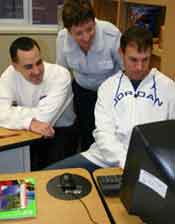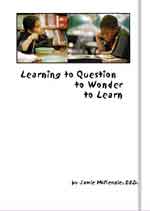|
A slam-dunk is worth 2 points on the basketball court, but in the classroom its value is immeasurable. The slam-dunk is considered one of the most visually impressive moves in all of basketball, but it can also refer to any notable success. Canyon Independent School District has experienced academic success by “slam-dunking” their classroom curriculum.
Curriculum coordinators in Canyon ISD joined together to provide possible staff development opportunities that would promote higher-level questioning methods, technology integration, and student engagement. After much research, Jamie McKenzie's Slam Dunk Lessons seemed the perfect solution. The CISD coordinators immediately began developing a plan to implement McKenzie's Slam Dunk Lessons into their curriculum-driven staff development. (McKenzie, 2004)
With twelve campuses, 741 staff members, and 7,814 students, the implementation process was a challenge. A train-the-trainer format seemed the most efficient means of providing professional development to everyone. The decision was made to train the advanced academic team, which consisted of one teacher per campus. Twelve trainers and two district coordinators attended Jamie McKenzie's “Making Slam Dunk Digital Lessons” workshop during which each attendee created a Slam Dunk Lesson based on the state curriculum standards. These lessons were posted to the district's web site for student participation and training purposes.
Spreading the Good Word
 |
Each campus trainer was responsible for determining the best means of delivering the Slam Dunk Lesson module to their faculty. Trainers chose to make presentations on scheduled district in-service days or during faculty meetings for professional development credit. Depending on the individual campus, the sessions varied from basic presentations to hands-on training where each teacher had their own computer. |
Following the first campus training, it was evident that the new theory had gained acceptance across every grade level and teaching assignment. Teachers were excited about the possibility of designing lessons that would engage students in powerful thought. Teachers realized immediately that asking the right question was the key to receiving quality results. The fact that the lessons could be easily created with Microsoft PowerPoint was especially appealing to the district's staff, all of whom had previously demonstrated proficiency with the program. Using a software program that the teachers were familiar with allowed them to focus on the curriculum, not the technology.
 |
Stories of Success
Several teachers immediately implemented the Slam Dunks into their lessons. Judy Glueck, eighth grade science teacher at Canyon Junior High School, had this to say following a Slam Dunk Lesson:
"The Slam Dunk Lesson has spiraled my pre-Advanced Placement science class to a new height regarding higher-level thinking. The students enjoyed the additional challenge the activity provided, and it became apparent that combining the science content with technology became a highly effective motivational tool. Taking Bloom's Taxonomy into consideration, students went from analysis to synthesis in the lesson. Now the students come in every day and ask if we're doing another thinking lesson on the computer!"
|
Kim Beth Buchanan, Canyon High School Assistant Principal of Curriculum and Student Performance was one of the original twelve teacher trainers that attended McKenzie's workshop. Buchanan was instrumental in training the entire Canyon High School staff in the use of questioning techniques and Slam Dunk Lessons for student engagement.
Buchanan says, “One of the biggest challenges of teaching 21st century students is engaging them in the subject matter and with their assignments. Slam Dunk Lessons have proven to meet this challenge because they focus on specific research areas and information sources while creating student ownership through creative questioning. Students use technology as a tool in the active endeavors of doing, exploring, and sharing."
| During the Canyon High School hands-on professional development training led by Buchanan, world geography teachers Andrew Neighbors and Kurt Richardson collaborated to create the “World Religions” Slam Dunk Lesson. Neighbors, who integrates technology regularly in his classroom curriculum, was excited to see the level of student engagement increase with the implementation of the lesson. |
 |
 |
Neighbors says, "The Slam Dunk Lesson helps the students be organized and stay on task. At the same time it gives them ownership in their work, allows creativity, and accomplishes all of this in a technology-based setting. The students really get into this type of lesson." When asked, one of Mr. Neighbors's students responded by saying, "I enjoyed the lesson on the computer because it kept me interested and more involved than a lecture or a presentation on the board." |
After attending the Slam Dunk staff development, Donna Cavrich, Canyon High School sophomore pre-Advanced Placement English teacher, decided to take a new approach to the same research project she had assigned for several years. In the past, students completed fact-based research over the Victorian and Regency era prior to reading the novel Pride and Prejudice.
 |
After Slam Dunk training, Cavrich transformed the fact-based research assignment into a powerful lesson by using thought-provoking questions that enhanced the quality of the final product. "The lesson is something I have done with my students for years. However, by assigning a question to the research, it made the students really think about their projects differently,” said Cavrich. |
It became apparent that the Slam Dunk Lessons were not only successful for secondary teachers but worked equally as well in the elementary classroom. Kathleen Herring, fourth grade teacher at Lakeview Elementary School, designed a lesson focusing on fascinating scientists. Herring took a unique approach to the lesson by using the same template to create five individual lessons that contained different scientists.
 |
Herring states, “Slam dunk lessons have revolutionized the way my students use the Internet to perform research! Once the students start, they are totally immersed in learning and actually groan when it is time to quit. With one question, they become so engrossed in a topic they don't realize that they are answering many questions. Another advantage is that the students differentiate the lesson themselves. This allows the students to learn at their own level and pace, but more importantly, if the student is engaged they really take off.”
|
Advantages of Slam Dunk Lessons
From high school English to the kindergarten classroom, the Slam Dunk Lesson differentiates learning for all students including those with special needs. The essential question can be designed to encourage higher-level thinking across all grade and ability levels. Selecting quality Internet sites for the lesson will provide students with grade-appropriate reading levels, suitable content, and supportive graphics. The enrichment slide of the Slam Dunk template provides students with a variety of reinforcement activities that can meet or challenge the individual child's learning needs.
Document-based Questions
The district coordinators took the Slam Dunk concept one step further by working with teachers to create Slam Dunk Lessons that included document-based questions (DBQs) which further prepares students for advanced placement exams. The junior high and high school advanced placement curriculum requires students to be able to analyze and synthesis information contained in primary source materials to answer an essential question in an essay format. The Slam Dunk Lesson provides the perfect avenue for engaging students in the use of primary source materials for answering document-based questions. The Internet provides a multitude of websites with primary-based materials that teachers can incorporate into Slam Dunk Lessons.
The Fast Break
Slam Dunk Lessons have scored points with administrators, teachers and students at Canyon Independent School District. To begin a fast break toward visually impressive Slam Dunks, visit Canyon ISD's collection of engaging online lessons based on Jamie McKenzie's model.
Resources
Canyon Independent School District
http://www.canyonisd.net
McKenzie, Jamie. “Five Types of Digital Lessons,” From Now On, Volume 13, Number 9, Summer 2004.
Slam Dunk Lessons Created by Canyon ISD Teachers
http://www.canyonisd.net/technology/activities/slamdunk/slamdunk.htm
Debbie Boyer and Karen Brooks
Curriculum Coordinators
Canyon Independent School District
Canyon, Texas
This article is © 2005 by Debbie Boyer and Karen Brooks, all rights reserved.
|

